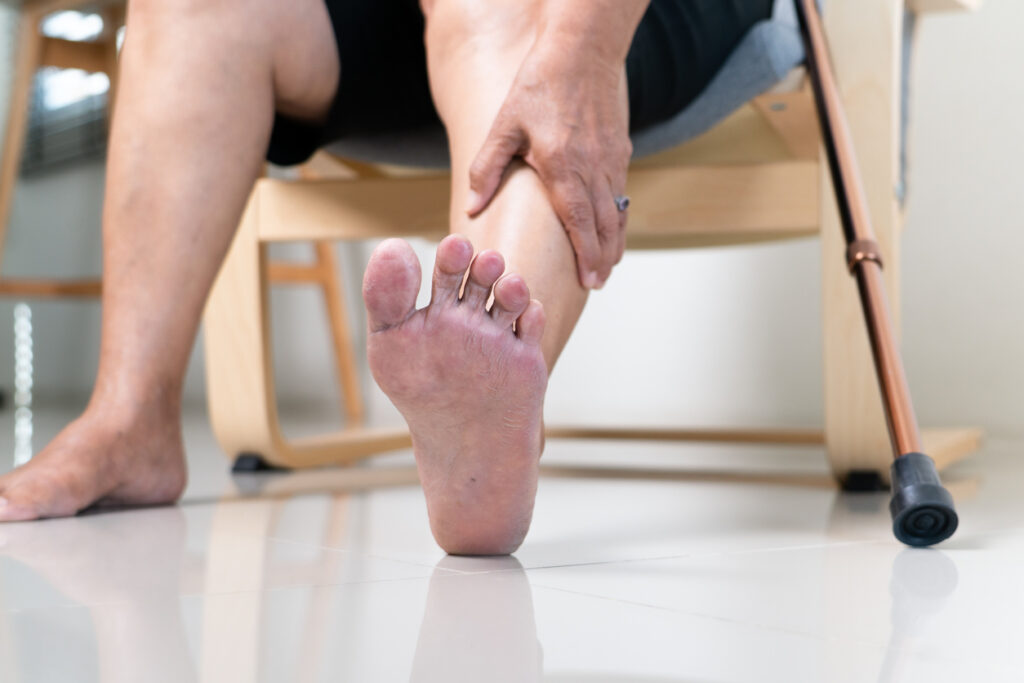If you have a diabetic foot ulcer, taking care of it is essential to reducing your risk for an infection that could potentially lead to amputation. Here’s everything you need to know about wound care for diabetic foot ulcers and treatment options.
What Is a Diabetic Foot Ulcer?
Also known as a diabetic ulceration, a diabetic foot ulcer is an open wound or sore that develops on the bottom of the foot in people who have diabetes—a condition characterized by chronically high blood sugar levels. Over time, high blood sugar levels can damage nerves and blood vessels in the feet that make it difficult to feel foot wounds and delay their healing.
Why Is Wound Care for Diabetic Foot Ulcers Important?
If you are living with diabetes, taking care of your feet and inspecting them regularly can help you avoid diabetic foot ulcers and any related complications. A podiatrist can talk to you in greater detail about the development and complications of diabetic foot ulcers and the role that proper diabetic foot care plays in your overall health.
What Are Treatments for a Diabetic Foot Wound?
Debridement, off-loading, and dressings are the most common treatments for a diabetic foot wound. The goal of diabetic foot wound treatment is to heal the ulcer as quickly as possible to prevent it from progressing into an infection.
Debridement
Diabetic foot ulcer debridement involves removing dead skin and tissue on the wound. First, your podiatrist will clean and disinfect the wound. Then, a metal instrument will be used to probe your wound to determine its depth and to check whether there is a foreign object in the ulcer. Your podiatrist will then remove the dead tissue using a scalpel and wash out the ulcer to prevent infection.
Off-Loading
Off-loading involves taking pressure off the foot with the ulcer until the wound has fully healed. This treatment can often accelerate the healing process. A foot brace, cast, crutches, custom orthotics, or a wheelchair may be used to aid in off-loading.
Dressings
A variety of dressings can be used to treat a diabetic foot ulcer. First, your podiatrist may try wet-to-dry dressings, which are wet when applied, then absorb tissue from your wound as the dressing dries. Other dressings your podiatrist may use to treat your wound are those that contain medicine and skin substitutes—tissue-like materials that temporarily replace the form and function of your skin.
Your podiatrist can recommend the best wound dressing for a diabetic foot ulcer and show you how to properly care for your wound at home using the dressing.
What Is the Best Wound Care for a Diabetic Foot Ulcer?
There are several key factors involved in the appropriate treatment of a diabetic foot ulcer, according to the American Podiatric Medication Association (APMA). These factors are:
- Prevention of infection
- Off-loading
- Debridement
- Application of medication or dressings
- Proper diabetes management
Your podiatrist can help you determine the best course of treatment based on the location, severity, and cause of your foot ulcer. In some instances, your podiatrist may perform a series of non-invasive tests to evaluate your blood circulation levels, given how circulation plays an important role in wound healing.
How Can I Prevent a Foot Ulcer?
Controlling your blood sugar level and managing diabetes are the most effective ways to prevent a foot ulcer. Your primary care provider can work with you to manage your condition, which often involves taking your diabetes medication as directed, exercising regularly, eating nutritious foods, and avoiding smoking and heavy alcohol use.
Other steps you can take to prevent a chronic diabetic foot ulcer wound include:
- Wearing shoes or slippers at all times, including indoors
- Wearing comfortable, supportive shoes that fit properly
- Trimming your toenails regularly
- Inspecting your feet daily for wounds
- Seeing your podiatrist regularly for a foot examination
If you do get a foot ulcer, see your podiatrist right away for treatment. Your podiatrist can discuss your available treatment options and help you reduce your risk for an infection.



